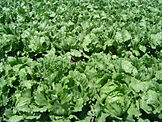Wikipedia:Today's featured article/September 28, 2021
Lettuce (Lactuca sativa) is an annual plant of the daisy family, Asteraceae, often grown as a leaf vegetable, and sometimes for its stem or seeds. Often used for salads, lettuce is also seen in other kinds of food, such as soups, sandwiches and wraps. In addition to its use as a leafy green, it has religious and medicinal significance. World production of lettuce and chicory for 2017 was 27 million tonnes, 56 percent of which came from China. Generally grown as a hardy annual, lettuce is easily cultivated, although it requires relatively low temperatures to prevent it from flowering quickly. It can be plagued by numerous nutrient deficiencies, as well as insect and mammal pests, and fungal and bacterial diseases. Lettuce is a rich source of vitamin K and vitamin A, and a moderate source of folate and iron. Contaminated lettuce can be a source of bacterial, viral, and parasitic outbreaks in humans, including E. coli and Salmonella. (Full article...)

